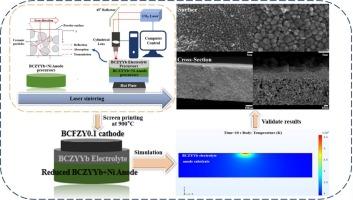液体辅助原位CO2激光快速反应烧结质子陶瓷材料的理论建模
IF 4.6
2区 工程技术
Q2 ENGINEERING, CHEMICAL
引用次数: 0
摘要
在质子导电的固态电化学器件(如质子陶瓷燃料电池)中,电解质的致密化和电极的多孔结构对其性能和稳定性至关重要,其中烧结过程起着决定性的作用。传统烧结需要长时间的高温处理,导致元素蒸发,能耗高,加工时间长,成本增加。为了解决这些问题,液相辅助原位CO₂快速激光反应烧结(RLRS)技术利用高能激光进行局部快速加热,显示出显著的优势。本研究建立了RLRS理论模型,研究了不同激光参数对阳极多孔结构和沉积BaCe0.7Zr0.1Yb0.1Yb0.1O₃-δ (BCZYYb)电解质致密化的影响,并确定了最佳工艺。实验证实,在此工艺下,电解质致密且具有阳极多孔性,结合紧密,不分层、不开裂,具有优异的电化学性能。本文章由计算机程序翻译,如有差异,请以英文原文为准。

Theoretical modeling for liquid-assisted in-situ CO2 rapid laser reactive sintering of protonic ceramic materials
In proton-conducting solid-state electrochemical devices (such as protonic ceramic fuel cells), the densification of electrolytes and the porous structure of electrodes are crucial for performance and stability, with the sintering process playing a decisive role. Conventional sintering requires prolonged high-temperature treatment, leading to elemental evaporation, high energy consumption, long processing time, and increased costs. To address these issues, the liquid-phase-assisted in-situ CO₂ rapid laser reactive sintering (RLRS) technique demonstrates significant advantages by utilizing high-energy laser for localized rapid heating. This study established a theoretical model of RLRS to investigate the effects of different laser parameters on the porous structure of the anode and the densification of the deposited BaCe0.7Zr0.1Yb0.1Yb0.1O₃-δ (BCZYYb) electrolyte, and determined the optimal process. Experiments have confirmed that under this process, the electrolytes are dense and anodic porous, they are tightly bonded, do not delaminate or crack, and have excellent electrochemical properties.
求助全文
通过发布文献求助,成功后即可免费获取论文全文。
去求助
来源期刊

Powder Technology
工程技术-工程:化工
CiteScore
9.90
自引率
15.40%
发文量
1047
审稿时长
46 days
期刊介绍:
Powder Technology is an International Journal on the Science and Technology of Wet and Dry Particulate Systems. Powder Technology publishes papers on all aspects of the formation of particles and their characterisation and on the study of systems containing particulate solids. No limitation is imposed on the size of the particles, which may range from nanometre scale, as in pigments or aerosols, to that of mined or quarried materials. The following list of topics is not intended to be comprehensive, but rather to indicate typical subjects which fall within the scope of the journal's interests:
Formation and synthesis of particles by precipitation and other methods.
Modification of particles by agglomeration, coating, comminution and attrition.
Characterisation of the size, shape, surface area, pore structure and strength of particles and agglomerates (including the origins and effects of inter particle forces).
Packing, failure, flow and permeability of assemblies of particles.
Particle-particle interactions and suspension rheology.
Handling and processing operations such as slurry flow, fluidization, pneumatic conveying.
Interactions between particles and their environment, including delivery of particulate products to the body.
Applications of particle technology in production of pharmaceuticals, chemicals, foods, pigments, structural, and functional materials and in environmental and energy related matters.
For materials-oriented contributions we are looking for articles revealing the effect of particle/powder characteristics (size, morphology and composition, in that order) on material performance or functionality and, ideally, comparison to any industrial standard.
 求助内容:
求助内容: 应助结果提醒方式:
应助结果提醒方式:


